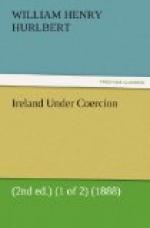This hotel was for many years the home of Lord George Hill, who built it in the hope of making Gweedore, what in England or Scotland it would long ago have become, a prosperous watering-place. Now that a battle-royal is going on between Lord George’s son and heir and the tenants on the estate, organised by Father M’Fadden under the “Plan of Campaign,” it is important to know something of the history of the place.
Is this a case of the sons of the soil expropriated by an alien and confiscating Government to enrich a ruthless invader? I was told by a Nationalist acquaintance in Dublin that the owner of Gweedore is a near kinsman of the Marquis of Londonderry, and that the property came to him by inheritance under an ancient confiscation of the estates of the O’Dounels of Tyrconnel. All of this I find is embroidery.
The “Carlisle” room, which our landlord has assigned to us, contains a number of books, the property of the late Lord George, and ample materials are here for making out the annals of Gweedore. Lord George, it seems, was a posthumous son of the fourth Marquis of Downshire, and a nephew of that Marchioness of Salisbury who was burned to death with the west wing of Hatfield House half a century ago. He inherited nothing in Donegal, nor was any provision made for him under his father’s will. His elder brothers made up and settled upon him a sum of twenty thousand pounds. He entered the Army, and being quartered for a time at Letterkenny, shot and fished all about Donegal. He found the people here kindly and friendly, but in a deplorable state of ignorance and of destitution. Their holdings under sundry small proprietors were entirely unimproved, and as their families increased, these holdings were cut up by themselves into even smaller strips under the system known as “rundale,”—each son as he grew up taking off a slice of the paternal holding, putting up a hut with mud, and scratching the soil after his own rude fashion. This custom, necessarily fatal to civilisation, doubtless came down from the traditional times when the lands of a sept were held in common by the sept, before the native chieftains had converted themselves into landlords, and defeated Sir John Davies’s attempt to convert their tribal kinsmen into peasant proprietors.
Whatever its origin, it had reduced Gweedore, or “Tullaghobegly,” fifty years ago to barbarism. Nearly nine thousand people then dwelt here with never a landlord among them. There was no “Coercion” in Gweedore, neither was there a coach nor a car to be found in the whole district. The nominal owners of the small properties into which the district was divided knew little and cared less about them. The rents were usually “made by the tenants,”—a step in advance, it will be seen, of the system which the collective wisdom of Great Britain has for the last twenty years been trying to establish in Ireland. But they were only paid when it was convenient. An agent of one of these properties who travelled fourteen miles one day to collect some rents gave it up and drove back again, because the “day was too bad” for him to wander about in the mountains on the chance of finding the tenants at home and disposed to give him a trifle on account. On most of the properties there were arrears of eight, ten, and twenty years’ standing.




